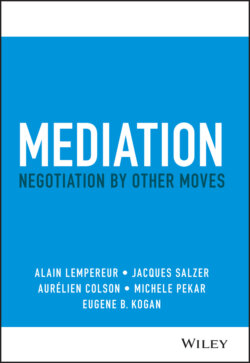Читать книгу Mediation - Alain Lempereur - Страница 27
Models, Methods, and Practices
ОглавлениеWhat do we mean by these three expressions?
Models – By “models” we do not mean examples to follow, but rather broad types of mediation approaches, featuring the characteristics representative of most mediators (Lempereur, 1999a). We can distinguish, for example, mediators as advisers or as facilitators.
Mediators as advisers try and find solutions for the parties. Such mediators, also called evaluative, provide, after listening to the parties, suggestions which they find relevant, balanced, and fair. Parties remain free to follow or not to follow this advice, to modify or adjust it.
Mediators as facilitators help the parties find their own solutions. Such mediators, also called facilitative (Brown 2002), do not offer any solutions, but try to make solutions emerge from the dialogue between parties. They invite parties to explain their views and hopefully acknowledge each other. Like midwifes, they make them ready for, or facilitate, a joyful birth at the ripe time. They consider that parties always understand their problems better than a mediator so that they can deliver their own best possible solutions themselves.
At the crossroads of the two models are the evocative mediators, who are providers of ideas – but not givers of lessons. Based on their own personal experience, mediators add to the ideas of the parties, if the parties did not get them by themselves. This is done not as “advice” but as a “gift of ideas,” without prejudging whether the parties will perceive these solutions as suitable or not. In short, these mediators wonder aloud about the adequacy of this or that solution. Knowing that they are not a party to the conflict, they offer without advising, insisting, pressing, or pretending in any way to alone hold the keys to the just or fair solution.
Depending on whether they claim to be an adviser or a facilitator, mediators do not use the same resources. According to a classical typology (French and Raven 1959), mediators can leverage different power resources vis‐à‐vis the parties: they can demonstrate expertise that the parties trust; their status may grant them special legitimacy; the parties can value their relationship with them; they may have crucial information which they can make available to the parties; or they can reward or exert pressure on the parties.
Methods – Within these three overarching models, mediators make method choices. That is to say, they select reasoned approaches to achieve their goals. This is flexibility within the framework. There are many method choices, and we will come back to them. For example, is there, at the opening, an oral agreement or a written contract on the rules of the mediation process? Do we communicate in writing or orally, face to face, by videoconference or by phone? How is the time dedicated to analyzing the past allocated in relation to that spent exploring possible avenues for the future? Is the final agreement drawn up by the parties, their lawyers, or the mediators themselves under the supervision of the parties?
Practices – At a more detailed level, within the choices of methods, each mediator brings their own personal “way of proceeding.” Mediation style may also vary in the same person, depending on the situations encountered. Mediation styles will crystallize in the details of the choice of words, the ways of welcoming, the handling of space and time, the questions asked, the use of silence, the transition from oral ideas to putting the solution in writing, and other various initiatives of mediators.
